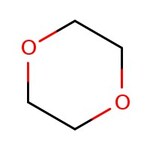Search Thermo Fisher Scientific
1,4-Dioxane, 99+ %, stab. avec environ 5-10 ppm de BHT, Thermo Scientific Chemicals



1,4-Dioxane, 99+ %, stab. avec environ 5-10 ppm de BHT, Thermo Scientific Chemicals
Identifiants chimiques
Spécifications
Description
This Thermo Scientific Chemicals brand product was originally part of the Alfa Aesar product portfolio. Some documentation and label information may refer to the legacy brand. The original Alfa Aesar product / item code or SKU reference has not changed as a part of the brand transition to Thermo Scientific Chemicals.
Le 1,4-dioxane est utilisé comme stabilisant pour le 1,1,1-trichloroéthane et les solvants chlorés. Il agit comme un solvant pour l’acétate de cellulose, l’éthylcellulose, la cellulose benzyle, les résines, les huiles, les cires, les colorants, d’autres composés organiques et inorganiques. Il agit comme un substitut du tétrahydrofurane en raison de son point d’ébullition plus élevé et de sa toxicité réduite. De plus, il est utilisé comme étalon interne pour la spectroscopie RMN du proton dans l’oxyde de deutérium. Il joue un rôle important dans la numération par scintillation liquide dans les procédures biologiques et comme agent humidifiant et dispersant dans le traitement des textiles. Il est impliqué dans la préparation du diméthylmagnésium en réagissant avec le bromure de méthylmagnésium et dans la préparation de sections histologiques pour examen microscopique.
Solubilité
Miscible avec l’eau, les solvants organiques, les hydrocarbures aromatiques et les huiles.
Remarques
Hygroscopique. Incompatible avec l’oxygène, les agents oxydants, les halogènes, les agents réducteurs, les perchlorates et le triméthylaluminium.
Figures
Documentation et téléchargements
Certificats
Foire aux questions (FAQ)
Citations et références
Sécurité et manipulation
Classification of the substance or mixture
CLP classification - Regulation(EC) No 1272/2008
Label Elements
Signal Word
Danger
Hazard Statements
H319 - Causes serious eye irritation
H335 - May cause respiratory irritation
H350 - May cause cancer
Physical Hazards
H225 - Highly flammable liquid and vapor
EU Specific Hazard Statements
EUH019 - May form explosive peroxides
EUH066 - Repeated exposure may cause skin dryness or cracking
Precautionary Statements
P210 - Keep away from heat, hot surfaces, sparks, open flames and other ignition sources. No smoking
P280 - Wear protective gloves/protective clothing/eye protection/face protection
P303 + P361 + P353 - IF ON SKIN (or hair): Take off immediately all contaminated clothing. Rinse skin with water or shower
P304 + P340 - IF INHALED: Remove person to fresh air and keep comfortable for breathing
P305 + P351 + P338 - IF IN EYES: Rinse cautiously with water for several minutes. Remove contact lenses, if present and easy to do. Continue rinsing
P312 - Call a POISON CENTER or doctor if you feel unwell
Additional EU labelling
Restricted to professional users